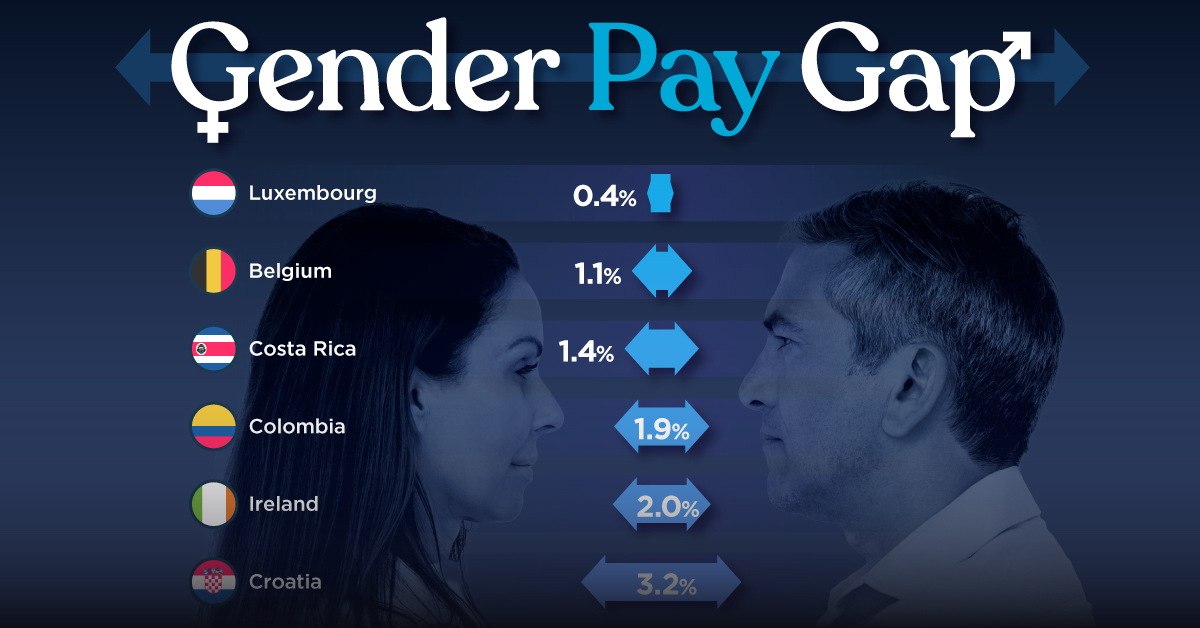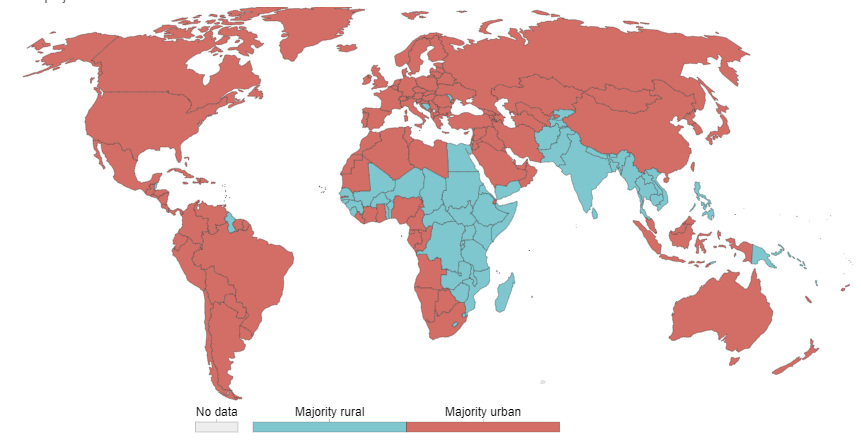Demographics
Mapping the World’s Urban Population in 2050
Click on any part of the map to see individual country breakdowns.
Mapping the World’s Urban Population from 1500 – 2050
In 133 BC, Rome was the first city to hit a population of one million people.
While that number might seem small now, the truth is that modern megacities are just a blip in the long timeline of human history.
Today’s interactive data visualization from Our World in Data maps out how many people have lived in urban areas over time, as well as the powerful economic pull of cities after the Industrial Revolution.
Shifting Human Geography
The stages of urbanization can be roughly broken into two parts.
1500s – 1900s
Most people lived an agrarian life until the first Industrial Revolution. The urban population quadrupled over this lengthy timeframe, from 4.1% to 16.4%.
Urbanization accompanied the moves away from agricultural employment, but it was still a slow burn until the 20th century.
1900s – Present
The expansion of the global economy and population saw urbanization skyrocket along with it. The urban public leaped from 16% to 55% today, a trend which comes from both births within urban areas and rising human migration out of rural areas.
This turning point between the centuries becomes pretty clear when we look at the population shifts relative to each other:
What Defines An Urban Area?
While this widely cited data comes from the United Nations, many researchers suggest that the actual numbers are much more dramatic.
Why is there a discrepancy? It turns out that the definition of an urban population varies widely around the world. The UN figures are based on nationally-defined urban shares – but the thresholds and metrics used to calculate these are not uniform. Here are just a few examples:
| Country | Definition |
|---|---|
| Argentina | Localities with 2,000 inhabitants or more. |
| Australia | Significant Urban Centres representing concentrations of urban development with 10,000 inhabitants or more. |
| Belgium | Communes with 5,000 inhabitants or more. |
| Canada | Areas with 1,000 inhabitants or more and at least 400 inhabitants per square kilometre. |
| Iceland | Localities with 200 inhabitants or more. |
| Japan | Cities defined as shi (A municipality that is 50,000 inhabitants or more); 60 per cent or more of the population engaged in urban type of business. |
| Netherlands | In the present publication, municipalities with 20,000 inhabitants or more. |
| Singapore | Entire population. |
| United States of America | Territory that meets minimum population density requirements and with 2,500 inhabitants or more. |
Cities That Never Sleep
In 1950, two-thirds of the global population lived in rural areas, but this distribution will be reversed in a matter of decades. Almost 70% of the world will live in urban areas by 2050.
In total, 2.5 billion people could be added to global urban areas by 2050, and a whopping 90% of this increase will take place in Asia and Africa.
By the time the dust has settled, large portions of the urban population will be concentrated in megacities, which are areas defined as having 10 million or more inhabitants. These are projected to be the top 10 megacities by the middle of the 21st century:
| City | Country | 2010 Population (millions) | 2050 Population (millions) |
|---|---|---|---|
| Mumbai | India | 20.1 | 42.4 |
| Delhi | India | 17 | 36.2 |
| Dhaka | Bangladesh | 14.8 | 35.2 |
| Kinshasa | DR Congo | 9 | 35 |
| Kolkata | India | 15.6 | 33 |
| Lagos | Nigeria | 10.6 | 32.6 |
| Tokyo | Japan | 36.1 | 32.6 |
| Karachi | Pakistan | 13 | 31.7 |
| New York | U.S. | 19.4 | 24.8 |
| Mexico City | Mexico | 20.1 | 24.3 |
Demographics
The Smallest Gender Wage Gaps in OECD Countries
Which OECD countries have the smallest gender wage gaps? We look at the 10 countries with gaps lower than the average.

The Smallest Gender Pay Gaps in OECD Countries
This was originally posted on our Voronoi app. Download the app for free on iOS or Android and discover incredible data-driven charts from a variety of trusted sources.
Among the 38 member countries in the Organization for Economic Cooperation and Development (OECD), several have made significant strides in addressing income inequality between men and women.
In this graphic we’ve ranked the OECD countries with the 10 smallest gender pay gaps, using the latest data from the OECD for 2022.
The gender pay gap is calculated as the difference between median full-time earnings for men and women divided by the median full-time earnings of men.
Which Countries Have the Smallest Gender Pay Gaps?
Luxembourg’s gender pay gap is the lowest among OECD members at only 0.4%—well below the OECD average of 11.6%.
| Rank | Country | Percentage Difference in Men's & Women's Full-time Earnings |
|---|---|---|
| 1 | 🇱🇺 Luxembourg | 0.4% |
| 2 | 🇧🇪 Belgium | 1.1% |
| 3 | 🇨🇷 Costa Rica | 1.4% |
| 4 | 🇨🇴 Colombia | 1.9% |
| 5 | 🇮🇪 Ireland | 2.0% |
| 6 | 🇭🇷 Croatia | 3.2% |
| 7 | 🇮🇹 Italy | 3.3% |
| 8 | 🇳🇴 Norway | 4.5% |
| 9 | 🇩🇰 Denmark | 5.8% |
| 10 | 🇵🇹 Portugal | 6.1% |
| OECD Average | 11.6% |
Notably, eight of the top 10 countries with the smallest gender pay gaps are located in Europe, as labor equality laws designed to target gender differences have begun to pay off.
The two other countries that made the list were Costa Rica (1.4%) and Colombia (1.9%), which came in third and fourth place, respectively.
How Did Luxembourg (Nearly) Eliminate its Gender Wage Gap?
Luxembourg’s virtually-non-existent gender wage gap in 2020 can be traced back to its diligent efforts to prioritize equal pay. Since 2016, firms that have not complied with the Labor Code’s equal pay laws have been subjected to penalizing fines ranging from €251 to €25,000.
Higher female education rates also contribute to the diminishing pay gap, with Luxembourg tied for first in the educational attainment rankings of the World Economic Forum’s Global Gender Gap Index Report for 2023.
See More Graphics about Demographics and Money
While these 10 countries are well below the OECD’s average gender pay gap of 11.6%, many OECD member countries including the U.S. are significantly above the average. To see the full list of the top 10 OECD countries with the largest gender pay gaps, check out this visualization.
-

 Real Estate2 weeks ago
Real Estate2 weeks agoVisualizing America’s Shortage of Affordable Homes
-

 Technology1 week ago
Technology1 week agoRanked: Semiconductor Companies by Industry Revenue Share
-

 Money1 week ago
Money1 week agoWhich States Have the Highest Minimum Wage in America?
-

 Real Estate1 week ago
Real Estate1 week agoRanked: The Most Valuable Housing Markets in America
-

 Business1 week ago
Business1 week agoCharted: Big Four Market Share by S&P 500 Audits
-

 AI1 week ago
AI1 week agoThe Stock Performance of U.S. Chipmakers So Far in 2024
-

 Misc2 weeks ago
Misc2 weeks agoAlmost Every EV Stock is Down After Q1 2024
-

 Money2 weeks ago
Money2 weeks agoWhere Does One U.S. Tax Dollar Go?















